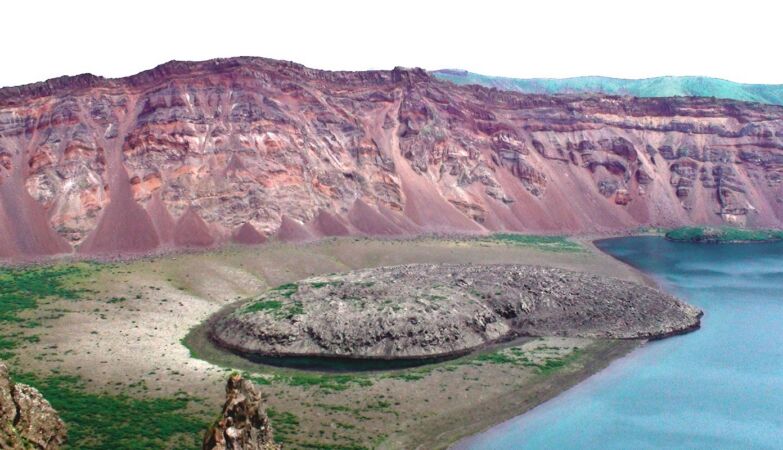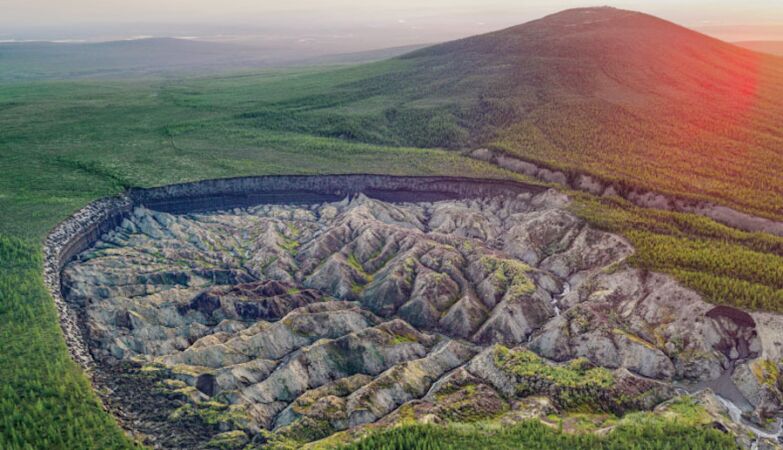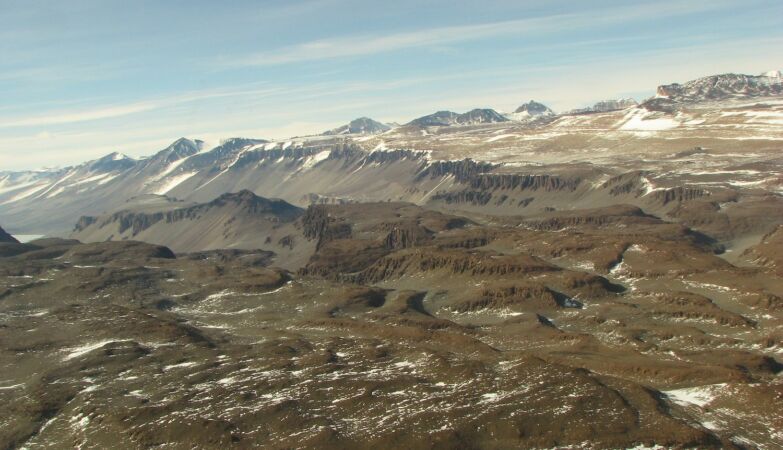domingo, junho 15, 2025
A erupção pliniana do Pinatubo, que afetou significativamente o clima da Terra, começou há 34 anos
Postado por
Fernando Martins
às
00:34
0
bocas
![]()
Marcadores: Alterações climáticas, erupção pliniana, Filipinas, Pinatubo, Vulcão
segunda-feira, março 31, 2025
Entretanto, na Venezuela....
Postado por
Fernando Martins
às
01:23
0
bocas
![]()
Marcadores: Alterações climáticas, glaciares, Pico Humboldt, Venezuela
sexta-feira, janeiro 03, 2025
Às vezes a causa de mudanças climáticas é geológica...
Encontrado o misterioso vulcão que há 200 anos quase destruiu o Mundo

A erupção misteriosa ocorreu no vulcão Zavaritskii, na ilha de Simushir, e criou uma caldeira com 3 km de largura, revelando espetaculares camadas vermelhas, pretas e brancas constituídas por depósitos eruptivos do passado
A identidade do misterioso do vulcão responsável por uma erupção vulcânica gigante que intrigou os cientistas durante quase 200 anos foi finalmente encontrada: foi o vulcão Zavaritskii, na remota e desabitada ilha de Simushir, parte das Ilhas Curilhas.
Em 1831, uma erupção vulcânica maciça lançou gases sulfurosos na atmosfera, refletindo a luz solar e provocando um arrefecimento global de cerca de 1ºC.
Este tempo frio, bem documentado em todo o mundo, levou a quebras de colheitas generalizadas e a fomes devastadoras.
O compositor Felix Mendelssohn chegou mesmo a escrever sobre o tempo catastrófico durante a sua viagem de verão pelos Alpes, em 1831: “Tempo desolador, voltou a chover toda a noite e toda a manhã, está tão frio como no inverno, já há neve profunda nas colinas mais próximas…”
A erupção de 1831 é a mais recente “erupção misteriosa” da Terra. Embora os cientistas soubessem que se tratava de um acontecimento importante que causou alterações climáticas e convulsões sociais, a identidade do vulcão responsável permaneceu desconhecida e ferozmente debatida, até agora.
Num novo estudo, uma equipa liderada por Will Hutchison, investigador da Universidade de St Andrews, analisou os registos do núcleo de gelo do evento de 1831 e identificou uma “correspondência perfeita das impressões digitais” dos depósitos de cinzas.
Os resultados do estudo foram apresentados num artigo publicado a semana passada na revista Proceedings of the National Academy of Sciences.
“Só nos últimos anos é que desenvolvemos a capacidade de extrair fragmentos microscópicos de cinzas de núcleos de gelo polar e efetuar análises químicas detalhadas. São incrivelmente minúsculos, com cerca de um décimo do diâmetro de um cabelo humano”, explica Hutchison num comunicado da universidade.
Hutchison e a sua equipa conseguiram datar com precisão e fazer corresponder os depósitos do núcleo de gelo ao vulcão Zavaritskii, na remota e desabitada ilha de Simushir, parte das Ilhas Curilhas.
Estas ilhas são um território disputado entre a Rússia e o Japão. Atualmente controladas pela Rússia, funcionam como um posto militar estratégico.
Durante a Guerra Fria, num enredo que faz lembrar um filme de Bond, os soviéticos utilizaram Simushir como base secreta de submarinos nucleares, atracando os navios numa cratera vulcânica inundada.
“Analisámos a química do gelo com uma resolução temporal muito elevada. Isto permitiu-nos identificar o momento exato da erupção, na primavera/verão de 1831, confirmar que foi altamente explosiva e depois extrair os pequenos fragmentos de cinzas”, acrescenta Hutchison.
“O momento no laboratório em que analisámos as duas cinzas juntas, uma do vulcão e outra do núcleo de gelo, foi um verdadeiro momento eureka. Não conseguia acreditar que os números eram idênticos”, conta Hutchison.
“Depois disso, passei muito tempo a investigar a idade e a dimensão da erupção nos registos de Kuril para me convencer verdadeiramente de que a correspondência era real“, admite.
Os resultados do estudo permitem identificar as Ilhas Kuril como uma região vulcânica pouco estudada mas extremamente produtiva.
O vulcão responsável pela erupção de 1831 era muito remoto, mas teve um impacto global significativo no clima e consequências graves para as populações humanas.
Identificar as fontes destas erupções misteriosas é crucial, pois permite aos cientistas cartografar e monitorizar as regiões da Terra com maior probabilidade de produzir eventos vulcânicos que alteram o clima.
“Há muitos vulcões como este, o que realça a dificuldade de prever quando ou onde poderá ocorrer a próxima erupção de grande magnitude. Como cientistas e como sociedade, temos de pensar em coordenar a resposta internacional quando ocorrer a próxima grande erupção, como a de 1831”, conclui.
in Wikipédia
Postado por
Fernando Martins
às
18:20
0
bocas
![]()
Marcadores: Alterações climáticas, Curilhas, vulcanismo, Vulcão
segunda-feira, julho 22, 2024
Nós, os humanos, damos cabo de tudo...
A Terra está a oscilar e os dias estão a ficar mais longos - e a culpa é nossa

Com a utilização da IA, novos estudos mostraram que os nossos dias estão a ficar cada vez mais longos e que o nosso Planeta vai ficar mais instável no futuro. Estas alterações podem ter implicações importantes para o futuro da humanidade.
Segundo o Live Science, a duração dos dias na Terra e a orientação do nosso Planeta estão a ser desequilibrados à medida que as alterações climáticas, causadas pelo Homem, alteram continuamente a rotação da Terra.
De acordo com uma nova investigação, estas alterações serão impercetíveis para nós, mas poderão ter graves repercussões, incluindo obrigar-nos a introduzir segundos bissextos negativos, interferir com as viagens espaciais e alterar o núcleo interno do nosso Planeta.
Um dia na Terra dura cerca de 86.400 segundos, mas o tempo exato que o nosso planeta leva a completar uma única rotação pode variar em pequenas frações de milissegundos todos os anos, devido a uma série de fatores, como os movimentos das placas tectónicas, as alterações da rotação do núcleo interno e o efeito gravitacional da Lua.
No entanto, as alterações climáticas causadas pelo Homem são outro fator que pode alterar a duração dos nossos dias e os cientistas estão apenas a começar a perceber o quanto isso afetará a rotação do nosso Planeta nos próximos anos.
Nas últimas décadas, a taxa de perda de gelo das regiões polares da Terra, em particular da Gronelândia e da Antártida, tem vindo a aumentar rapidamente devido ao aquecimento global, levando à subida do nível do mar.
A maior parte desta água extra acumula-se perto do equador, fazendo com que o nosso Planeta fique ligeiramente mais saliente a meio.
Isto, por sua vez, abranda a rotação do Planeta, porque o peso é distribuído mais longe do centro do Planeta - à semelhança do que acontece com os patinadores artísticos que giram, que abrandam a rotação afastando os braços do corpo.
No novo estudo, publicado na revista PNAS, os investigadores utilizaram um programa avançado de Inteligência Artificial que combina dados do mundo real com as leis da física para prever a forma como a rotação do planeta irá mudar ao longo do tempo.
A mesma equipa de investigação que está por detrás do novo estudo também divulgou um outro estudo, publicado na revista Nature Geoscience, que mostrava que o aumento da água perto do equador está a deslocar o eixo da rotação da Terra, o que está a fazer com que os polos magnéticos se afastem mais do eixo todos os anos.
Os cientistas descobriram anteriormente que este efeito tem vindo a ocorrer, provavelmente, pelo menos nas últimas três décadas. No entanto, o novo estudo sugere que o eixo se afastará ainda mais da sua posição atual do que os estudos anteriores previam.
“Nós, humanos, temos um impacto maior no nosso Planeta do que imaginamos”, afirmou Benedikt Soja, geodesista da ETH Zurich, coautor dos dois novos estudos. “E isto coloca-nos naturalmente perante uma grande responsabilidade pelo futuro do nosso Planeta”.
A duração dos dias da Terra sempre variou. Há cerca de mil milhões de anos, o nosso planeta demorava provavelmente apenas 19 horas a completar uma única rotação, antes de abrandar para as 24 horas que temos atualmente.
A Terra também muda em escalas de tempo mais curtas. Por exemplo, em 2020, a Terra estava a girar mais rapidamente do que em qualquer outro momento desde que os registos começaram em 1960.
Em 2021, a rotação do planeta começou a abrandar novamente, apesar de termos registado o dia mais curto de sempre em junho de 2022. Mas, no geral, a rotação da Terra tem vindo a abrandar há milénios, principalmente devido a um processo conhecido como fricção de maré lunar, em que o efeito gravitacional da Lua nos nossos oceanos afasta a água dos polos.
Mas, em geral, a rotação da Terra tem vindo a abrandar há milénios, principalmente devido a um processo conhecido como ficção de maré lunar, em que o efeito gravitacional da Lua nos nossos oceanos afasta a água dos polos.
Atualmente, esse efeito está a prolongar os nossos dias em cerca de 2,3 milissegundos por século.
Os novos estudos mostram que as alterações climáticas estão atualmente a prolongar os nossos dias em cerca de 1,3 milisegundos por século.
No entanto, com base nos atuais modelos de temperatura global, os investigadores preveem que este efeito possa aumentar para 2,6 milissegundos por século até ao final do século XXI, o que faria das alterações climáticas a maior influência na rotação do nosso planeta.
Um dos efeitos mais prováveis dos dias mais longos seria a necessidade de introduzir segundos bissextos negativos - em que ocasionalmente perderíamos um segundo de alguns dias futuros para acomodar o alongamento dos dias, à semelhança do que acontece com os anos bissextos.
O estudo de março sugere que isto poderá ter de começar a acontecer já em 2029, sobretudo para ter em conta o aumento do comprimento dos dias nos últimos milénios.
No passado, os cientistas sugeriam que esta introdução poderia afetar a contagem do tempo dos computadores e dos smartphones. No entanto, nem toda a gente está convencida de que este será um problema grave.
Os investigadores dos novos estudos observaram também que as futuras alterações poderiam ter impacto nas viagens espaciais.
“Mesmo que a rotação da Terra esteja a mudar apenas lentamente, este efeito tem de ser tido em conta quando se navega no espaço, por exemplo, quando se envia uma sonda espacial para aterrar noutro Planeta”, disse Soja. Por conseguinte, é importante monitorizar de perto estas alterações”.
A equipa também alertou para o facto de as mudanças no eixo de rotação da Terra poderem alterar a rotação do núcleo interno da Terra, o que poderia aumentar ainda mais a rapidez com que os dias se prolongam. No entanto, esta potencial interação é ainda largamente desconhecida.
in ZAP
Postado por
Fernando Martins
às
19:32
0
bocas
![]()
Marcadores: Alterações climáticas, tempo
sábado, junho 15, 2024
A erupção pliniana do Pinatubo, que afetou significativamente o clima da Terra, começou há 33 anos
Postado por
Fernando Martins
às
00:33
0
bocas
![]()
Marcadores: Alterações climáticas, erupção pliniana, Filipinas, Pinatubo, Vulcão
sexta-feira, maio 17, 2024
Se calhar é por causa das maldades que um ditador russo faz...
“Porta para o Inferno” siberiana está a rachar

Famoso “Portal para o Submundo” viu cerca de 35 milhões de metros cúbicos de terra serem deslocados desde a década de 90, ditou novo estudo com recurso a modelos geológicos em 3D.
Está a expandir-se a ritmos alarmantes e tornou-se um símbolo vivo das alterações climáticas e do seu efeito nas regiões de permafrost.
O “Portal para o Submundo” da Sibéria, localizado na República Sakha, começou numa pequena ravina na década de 60. Hoje, estende-se por mais de um quilómetro de comprimento e está a crescer.
Inicialmente despercebida até ser identificada por imagens de satélite em 1991, a derrocada tem sido monitorizada de perto desde então. A causa da sua expansão é atribuída, em grande parte, ao aumento das temperaturas, que descongelam o permafrost, outrora estável, desestabilizando a estrutura do solo e desencadeando deslocações maciças do solo para baixo, em direção ao rio Batagay.
Estudos recentes publicados no Geomorphology e conduzidos por uma equipa da Universidade Estatal Lomonosov de Moscovo e do Instituto Melnikov Permafrost, em colaboração com cientistas alemães, forneceram novas e mais aprofundadas informações sobre a dinâmica do abatimento, com recurso a modelos geológicos em 3D, segundo o IFL Science.
As descobertas indicam que cerca de 35 milhões de metros cúbicos de terra foram deslocados desde a década de 90, sendo que cerca de dois terços deste volume são constituídos por gelo terrestre e o restante por sedimentos de permafrost.
As dimensões do megaslump aumentaram notavelmente de 790 metros de largura em 2014 para 890 metros em 2019.
Esta transformação não decorre apenas em Batagay. Fenómenos semelhantes estão a ocorrer em todo o Ártico, onde as alterações climáticas estão a provocar derrocadas do permafrost e a desencadear numerosos deslizamentos de terras.
Estes desenvolvimentos são particularmente preocupantes na Rússia, onde o permafrost constitui quase 65% do terreno. A degradação contínua deste solo congelado coloca desafios substanciais, não só alterando as paisagens, mas também libertando quantidades significativas de carbono para a atmosfera, o que pode agravar ainda mais o aquecimento global.
in ZAP
Postado por
Fernando Martins
às
20:27
0
bocas
![]()
Marcadores: Alterações climáticas, aquecimento global, Cratera de Batagaika, depressão termocársica, deslizamento de, permafrost, Porta do Inferno, Porta para o Inferno, Portal para o Submundo, Rússia, Sibéria
quinta-feira, fevereiro 15, 2024
Alguns acham que está a dar o amoque à AMOC...!
Corrente fundamental do Oceano Atlântico está em colapso iminente
Uma nova pesquisa confirma os receios sobre um provável colapso da Circulação Meridional do Atlântico, que é fundamental para vários ecossistemas e para a cadeia alimentar global.
Um estudo publicado em julho do ano passado lançou o alerta: a Circulação Meridional do Atlântico (AMOC), um sistema crucial que regula o clima do Hemisfério Norte, pode entrar em colapso a qualquer momento a partir de 2025, lançando a Terra num caos climático.
Os resultados do estudo sugeriam que o colapso da AMOC originaria uma dramática queda nas temperaturas, o colapso dos ecossistemas oceânicos e o aumento global das tempestades.
Um novo estudo, publicado a semana passada na revista Science Advances traz agora preocupações agravadas sobre o potencial colapso desta corrente oceânica, uma das principais na Terra.
A pesquisa, liderada pelo oceanógrafo René van Westen da Universidade de Utrecht, introduz um sistema de alerta precoce baseado em observações físicas relacionadas ao transporte de salinidade na fronteira sul do Oceano Atlântico.
A AMOC desempenha um papel crucial no clima da Terra, transferindo água salgada e quente do sul para o norte.
Este processo é vital para manter o equilíbrio climático, mas a adição de água doce de glaciares derretidos e o aumento da precipitação estão a diminuir a salinidade da água, comprometendo este ciclo e ameaçando enfraquecer significativamente a AMOC.
Segundo os autores, uma vez atingido um determinado limiar de salinidade, o ponto de inflexão da AMOC poderá ocorrer num período de uma a quatro décadas, implicando mudanças climáticas drásticas e irreversíveis em escalas de tempo humanas, afetando severamente as sociedades ao redor do globo com alterações na temperatura, nível do mar e padrões de precipitação.
O sistema de monitorização direto da AMOC só foi implementado em 2004, o que limita a compreensão completa da sua trajetória de desaceleração. Por isso, os cientistas têm utilizado indicadores indiretos, como os níveis de salinidade, para preencher as lacunas de conhecimento, explica o Science Alert.
O estudo sugere que a AMOC é mais sensível às mudanças do que os modelos climáticos atuais preveem, confirmando preocupações anteriores de que os modelos climáticos superestimam sistematicamente a estabilidade da AMOC.
O possível colapso da AMOC traria extensas alterações climáticas, afetando ecossistemas inteiros e a segurança alimentar global.
Com a previsão de temperaturas mais baixas no noroeste da Europa, alterações nas monções tropicais e aquecimento adicional no Hemisfério Sul, o estudo adiciona urgência à preocupação crescente sobre um colapso iminente da AMOC.
in ZAP
Postado por
Fernando Martins
às
13:31
0
bocas
![]()
Marcadores: Alterações climáticas, AMOC, clima, oceanologia
quarta-feira, fevereiro 14, 2024
Notícia sobre evolução e alterações climáticas à escala do tempo geológico...
A Terra teve duas eras climáticas distintas nos últimos 66 milhões de anos. Já sabemos porquê

O impacto do meteorito Chicxulub e a glaciação do Hemisfério Sul foram dois importantes pontos de viragem no clima da Terra.
Uma nova investigação publicada na revista Scientific Reports revela detalhes sobre dois eventos climáticos significativos que moldaram o clima da Terra nos últimos 66 milhões de anos.
A pesquisa foi influenciada pela teoria do equilíbrio pontuado, que sugere que as espécies evoluem em surtos curtos e não gradualmente ao longo do tempo. Esta teoria foi adaptada para avaliar o impacto histórico das alterações climáticas, utilizando métodos estatísticos avançados para analisar duas séries de dados climáticos, explica o SciTech Daily.
Os resultados revelam dois eventos cruciais que dominaram a evolução climática da Terra. O primeiro é o impacto do meteorito Chicxulub no México, que levou à extinção de grandes dinossauros há cerca de 65,5 milhões de anos. Este evento marcou o início de um período quente com níveis elevados de CO2.
O segundo evento foi um ponto de viragem climático que ocorreu há 34 milhões de anos com a glaciação do Hemisfério Sul. O isolamento do continente antártico devido aos movimentos das placas tectónicas marcou uma nova era de um clima mais frio na Terra, que continua a influenciar o nosso sistema climático atual.
Este regime climático ainda está em vigor hoje, com a presença de grandes massas de gelo a desempenhar um papel crítico na manutenção do clima global. O estudo adverte que, se estas massas de gelo derreterem devido ao aquecimento global causado pelas atividades humanos, isso representaria outro ponto de viragem crucial, levando a uma nova e imprevisível paisagem climática.
Denis-Didier Rousseau, autor principal do estudo, alerta que as massas de gelo são “muito sensíveis” e já mostram sinais de derretimento. “Ultrapassar pontos de viragem tem sido uma característica recorrente na evolução climática,” acrescenta Valerio Lucarini, sublinhando a necessidade das estratégias de adaptação climática considerarem a desestabilização destes elementos climáticos críticos.
Como o estudo faz parte do projeto europeu TiPES, focado em pontos de viragem no Sistema Terrestre, os resultados contribuem para o nosso entendimento de como o clima da Terra poderá evoluir face ao impacto humano.
Postado por
Fernando Martins
às
13:15
0
bocas
![]()
Marcadores: Alterações climáticas, Chicxulub, clima, equilíbrio pontuado, evolução
quinta-feira, junho 15, 2023
A erupção do Pinatubo, que afetou significativamente o clima da Terra, começou há 32 anos
Postado por
Fernando Martins
às
00:32
0
bocas
![]()
Marcadores: Alterações climáticas, erupção pliniana, Filipinas, Pinatubo, Vulcão
quarta-feira, junho 15, 2022
A erupção do Pinatubo, que afetou significativamente o clima da Terra, começou há 31 anos
Postado por
Fernando Martins
às
00:31
0
bocas
![]()
Marcadores: Alterações climáticas, erupção pliniana, Filipinas, Pinatubo, Vulcão
terça-feira, junho 15, 2021
Uma erupção do Pinatubo afetou significativamente o clima em toda a Terra há trinta anos
Postado por
Fernando Martins
às
00:30
0
bocas
![]()
Marcadores: Alterações climáticas, erupção pliniana, Filipinas, Pinatubo, Vulcão
segunda-feira, junho 15, 2020
Começou há 29 anos uma erupção que afetou significativamente o clima em toda a Terra
Postado por
Fernando Martins
às
00:29
0
bocas
![]()
Marcadores: Alterações climáticas, erupção pliniana, Filipinas, Pinatubo, Vulcão
sábado, junho 15, 2019
O Pinatubo, vulcão das Flipinas, teve há 28 anos uma erupção que afetou o clima terrestre
2, bringing vast quantities of minerals and metals to the surface environment. It injected large amounts of particulate into the stratosphere – more than any eruption since that of Krakatoa in 1883. Over the following months, the aerosols formed a global layer of sulfuric acid haze. Global temperatures dropped by about 0.5 °C and ozone depletion temporarily increased substantially.
Postado por
Fernando Martins
às
00:28
0
bocas
![]()
Marcadores: Alterações climáticas, erupção pliniana, Filipinas, Pinatubo, Vulcão
quarta-feira, fevereiro 20, 2019
Há nove anos, a Meteorologia e erros humanos levaram a uma catástrofe na Madeira
Postado por
Fernando Martins
às
09:00
0
bocas
![]()
Marcadores: acidentes, Alterações climáticas, aluvião da Madeira, Funchal, Madeira, Meteorologia
domingo, junho 15, 2014
O Pinatubo, vulcão das Flipinas, teve há 23 anos uma erupção que afetou o clima do mundo inteiro
2, bringing vast quantities of minerals and metals to the surface environment. It injected large amounts of particulate into the stratosphere – more than any eruption since that of Krakatoa in 1883. Over the following months, the aerosols formed a global layer of sulfuric acid haze. Global temperatures dropped by about 0.5 °C and ozone depletion temporarily increased substantially.
Postado por
Fernando Martins
às
23:00
0
bocas
![]()
Marcadores: Alterações climáticas, erupção pliniana, Filipinas, Pinatubo, Vulcão
quinta-feira, fevereiro 20, 2014
Há quatro anos, a Meteorologia e os erros humanos levaram a uma grande catástrofe na Madeira
Postado por
Fernando Martins
às
04:00
0
bocas
![]()
Marcadores: acidentes, Alterações climáticas, aluvião da Madeira, Funchal, Madeira, Meteorologia
sábado, fevereiro 19, 2011
6th International Conference on Climate Change - the Karst Record
Postado por
Fernando Martins
às
00:20
0
bocas
![]()
Marcadores: Alterações climáticas, clima, Mudança climática, Profundezas...
sábado, maio 08, 2010
Colóquio sobre Alterações Climáticas na Marinha Grande
Divulga o evento e comparece...

Postado por
Adelaide Martins
às
17:04
0
bocas
![]()
Marcadores: Alterações climáticas, Colóquio, Marinha Grande, OIKOS Leiria









